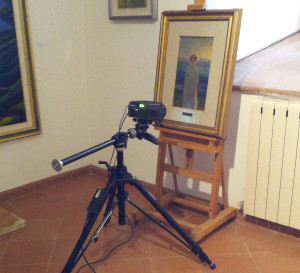
XRF analysis provides information about the atomic composition of the investigated surface. It is widely used in the field of Cultural Heritage because it is a relatively simple and rapid technique and can yield information about the nature of the pigments. The detection of key elements may give the direct identification of the pigments, in other cases XRF data are completed and integrated with molecular spectroscopies.
The instrumentation available at CNR-ISTM is the ELIO spectrometer (XGLab). It consists of a Silicon Drift Detector cooled by a Peltier system, with an active area of 25 mm2 and a resolution of The instrumentation available at CNR-ISTM is the ELIO spectrometer (XGLab). It consists of a Silicon Drift Detector cooled by a Peltier system, with an active area of 25 mm2 and a resolution of < 135eV to the Kα line of Mn. The source is the Rhodium with a maximum power of 50kV and maximum current of 200 uA. The spatial resolution is about 1 mm.
